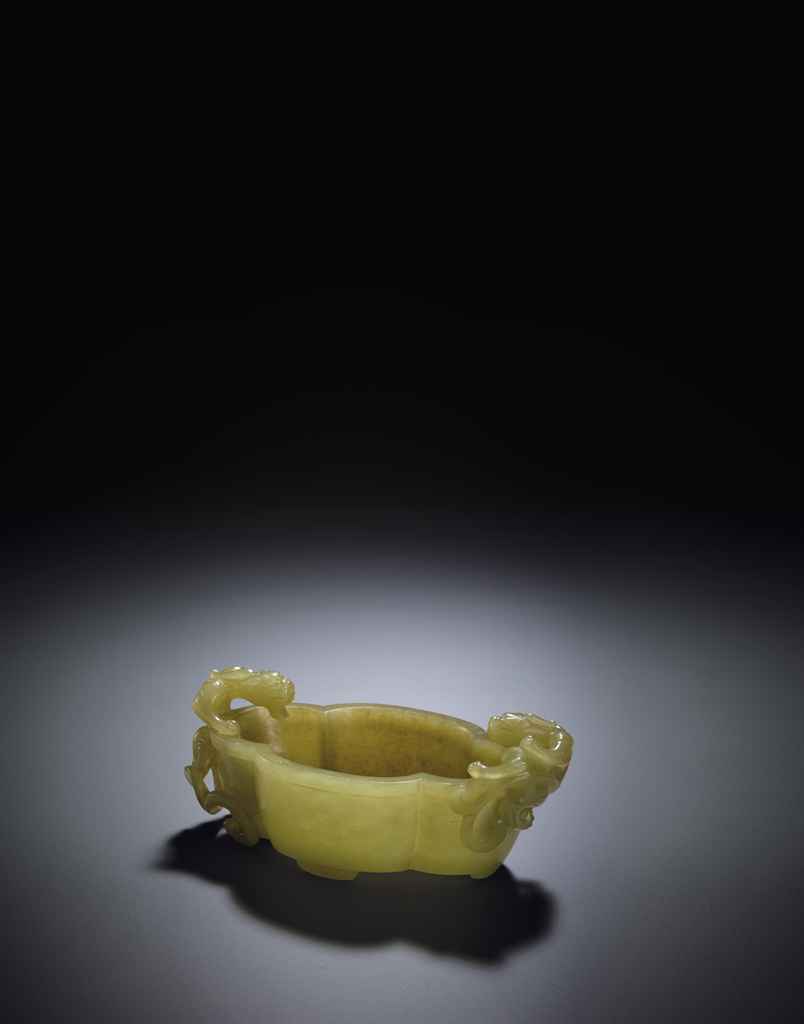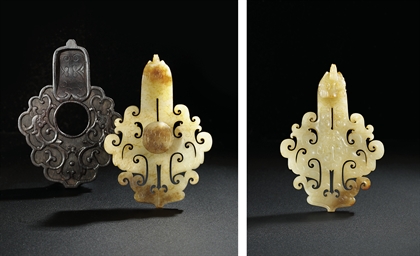Lot details China, 1736-1795. Of flattened form and rectangular section, the ruyi-shaped body supported on a thick spreading foot and rising to a waisted neck flanked by two distinct elephant handles suspending mock rings. Superbly carved with two lotus sprays on each side, one within the ruyi-shaped apron and the other to the neck against a finely incised wan ground, with a band of ruyi-heads below the mouth and archaistic comma-spirals above the foot. The translucent stone of an intense and pure yellow tone. The recessed base incised with a four-character mark Qianlong nianzhi and of the period. Provenance: Formerly the property of a gentleman in Paris. Condition: Very good condition with minor wear, small nicks to exposed areas, occasional light scratches, the foot possibly smoothened. Weight: 182.5 g Dimensions: Height 10.6 cm With a carved and fitted hardwood stand, Qing Dynasty, possibly 18th century. (2) Among nephrite jades of ink-black, spinach-green, celadon, yellow, and white tones, it is the yellow jades that were considered as the most rare. As early as 1388, it is recorded in the Gegu yaolun (The Essential Criteria of Antiquities), that the best yellow jade should be stones with the “colour of the chestnut kernel, known also as pure [literally ‘sweet’] yellow, are the most valuable. The smoky yellow is the next in quality”, see Sir Percival David, Chinese Connoisseurship, London, 1971, p. 120. The varying yellow tones are subtle and difficult to differentiate. Yang Boda distinguished them in Zhongguo Yuqi Quanji, Vol. 6, Hebei, 1991. The yellow jades of chestnut tone are particularly precious and valuable, such as the archaistic baluster vase in the Palace Museum Collection, decorated with taotie masks between cicada motifs, ibid. p. 591, no. 204. The other categories of yellow are known as 'corn kernel', ibid. p. 588, no. 190 (a pear-shaped archaistic vase), 'sweet pear', p. 544, no. 41 (a jade rhyton), 'interior with light celadon shimmer', ibid. p. 598, no. 235 (a recumbent elephant supporting a vase on its back), and 'autumn mallow', ibid. p. 600, no. 241 (a cylindrical covered vase). Literature comparison: The ruyi-shaped body as seen on the present vase is extremely rare. For a celadon-glazed vase and cover, with a Qianlong mark and of the period, with a similar ruyi-shaped body and apron, see Sotheby’s Hong Kong, 3 October 2018, lot 3602. Auction result comparison: Compare a related yellow jade vase and cover, 12.5 cm high, also with a Qianlong four-character reign mark, at Christie’s Hong Kong in The Imperial Sale on 31 May 2010, lot 2121, sold for HKD 2,660,000. Compare a related ‘autumn mallow’ yellow jade baluster vase, 14.6 cm high, dated to the Qianlong period, at Christie’s London in Fine Chinese Ceramics and Works of Art on 15 May 2007, lot 374, sold for GBP 52,800. 乾隆款及年代罕見黃玉如意瓶 中國,1736-1795年。瓶身扁平,長頸,象首啣環輔耳,如意形腹部,底足外撇並內凹。淺浮雕,唇沿處飾如意紋,頸部萬字元地上纏枝蓮紋,腹部中央飾蓮紋,邊沿處雲紋。柔和淡雅的的黃色的半透明玉料。底足內刻“乾隆年製”四字。 來源:巴黎一位紳士收藏。 品相:狀況極好,有輕微磨損,局部有小劃痕和輕微刻痕,底部光滑。 重量:182.5 克 尺寸:高10.6厘米 清代硬木底座,可能為十八世紀。 在玉的不同成色中, 如白、青、碧、黃、黑等,黃玉被認為是最稀有且珍貴的。 早在1388年,《格古要論》中就有記載”黃玉如粟者為貴,謂之甘黃“ ,而煙熏黃是之後一等,見 Sir Percival David, Chinese Connoisseurship, 倫敦,1971年,第120頁。 不同的黃色色調微妙且難以區分。 楊伯達在《中國玉器全集》第六冊(河北,1991年)中對他們進行了區分:栗色黃玉尤為珍貴,如故宮收藏的仿古賞瓶,蟬紋間饕餮紋飾,第591頁,圖204;其他類別的黃色被稱為“玉米粒”,第588頁,圖190(一個梨形的古花瓶),“糖黃玉”,第 544頁,圖 4;“內部帶有淺青瓷微光”,第 598頁,圖235(太平有象)和“秋葵”,第600頁,圖 241(圓柱形蓋瓶)。 文獻比較:此拍品的如意形腹部極爲少見。相似形制可參考一件乾隆款及年代青釉蓋瓶,見香港蘇富比2018年10月3日 lot 3602。 拍賣結果比較:比較一件黃玉蓋瓶,高12.5 釐米,同樣有乾隆四字款,見香港佳士得The Imperial Sale 2010年5月31日 lot 2121, 售價HKD 2,660,000;比較一件乾隆時期黃玉秋葵賞瓶,高14.6 釐米,見倫敦佳士得 Fine Chinese Ceramics and Works of Art 2007年5月15日 lot 374, 售價GBP 52,800。
Lot details China, 1736-1795. Of flattened form and rectangular section, the ruyi-shaped body supported on a thick spreading foot and rising to a waisted neck flanked by two distinct elephant handles suspending mock rings. Superbly carved with two lotus sprays on each side, one within the ruyi-shaped apron and the other to the neck against a finely incised wan ground, with a band of ruyi-heads below the mouth and archaistic comma-spirals above the foot. The translucent stone of an intense and pure yellow tone. The recessed base incised with a four-character mark Qianlong nianzhi and of the period. Provenance: Formerly the property of a gentleman in Paris. Condition: Very good condition with minor wear, small nicks to exposed areas, occasional light scratches, the foot possibly smoothened. Weight: 182.5 g Dimensions: Height 10.6 cm With a carved and fitted hardwood stand, Qing Dynasty, possibly 18th century. (2) Among nephrite jades of ink-black, spinach-green, celadon, yellow, and white tones, it is the yellow jades that were considered as the most rare. As early as 1388, it is recorded in the Gegu yaolun (The Essential Criteria of Antiquities), that the best yellow jade should be stones with the “colour of the chestnut kernel, known also as pure [literally ‘sweet’] yellow, are the most valuable. The smoky yellow is the next in quality”, see Sir Percival David, Chinese Connoisseurship, London, 1971, p. 120. The varying yellow tones are subtle and difficult to differentiate. Yang Boda distinguished them in Zhongguo Yuqi Quanji, Vol. 6, Hebei, 1991. The yellow jades of chestnut tone are particularly precious and valuable, such as the archaistic baluster vase in the Palace Museum Collection, decorated with taotie masks between cicada motifs, ibid. p. 591, no. 204. The other categories of yellow are known as 'corn kernel', ibid. p. 588, no. 190 (a pear-shaped archaistic vase), 'sweet pear', p. 544, no. 41 (a jade rhyton), 'interior with light celadon shimmer', ibid. p. 598, no. 235 (a recumbent elephant supporting a vase on its back), and 'autumn mallow', ibid. p. 600, no. 241 (a cylindrical covered vase). Literature comparison: The ruyi-shaped body as seen on the present vase is extremely rare. For a celadon-glazed vase and cover, with a Qianlong mark and of the period, with a similar ruyi-shaped body and apron, see Sotheby’s Hong Kong, 3 October 2018, lot 3602. Auction result comparison: Compare a related yellow jade vase and cover, 12.5 cm high, also with a Qianlong four-character reign mark, at Christie’s Hong Kong in The Imperial Sale on 31 May 2010, lot 2121, sold for HKD 2,660,000. Compare a related ‘autumn mallow’ yellow jade baluster vase, 14.6 cm high, dated to the Qianlong period, at Christie’s London in Fine Chinese Ceramics and Works of Art on 15 May 2007, lot 374, sold for GBP 52,800. 乾隆款及年代罕見黃玉如意瓶 中國,1736-1795年。瓶身扁平,長頸,象首啣環輔耳,如意形腹部,底足外撇並內凹。淺浮雕,唇沿處飾如意紋,頸部萬字元地上纏枝蓮紋,腹部中央飾蓮紋,邊沿處雲紋。柔和淡雅的的黃色的半透明玉料。底足內刻“乾隆年製”四字。 來源:巴黎一位紳士收藏。 品相:狀況極好,有輕微磨損,局部有小劃痕和輕微刻痕,底部光滑。 重量:182.5 克 尺寸:高10.6厘米 清代硬木底座,可能為十八世紀。 在玉的不同成色中, 如白、青、碧、黃、黑等,黃玉被認為是最稀有且珍貴的。 早在1388年,《格古要論》中就有記載”黃玉如粟者為貴,謂之甘黃“ ,而煙熏黃是之後一等,見 Sir Percival David, Chinese Connoisseurship, 倫敦,1971年,第120頁。 不同的黃色色調微妙且難以區分。 楊伯達在《中國玉器全集》第六冊(河北,1991年)中對他們進行了區分:栗色黃玉尤為珍貴,如故宮收藏的仿古賞瓶,蟬紋間饕餮紋飾,第591頁,圖204;其他類別的黃色被稱為“玉米粒”,第588頁,圖190(一個梨形的古花瓶),“糖黃玉”,第 544頁,圖 4;“內部帶有淺青瓷微光”,第 598頁,圖235(太平有象)和“秋葵”,第600頁,圖 241(圓柱形蓋瓶)。 文獻比較:此拍品的如意形腹部極爲少見。相似形制可參考一件乾隆款及年代青釉蓋瓶,見香港蘇富比2018年10月3日 lot 3602。 拍賣結果比較:比較一件黃玉蓋瓶,高12.5 釐米,同樣有乾隆四字款,見香港佳士得The Imperial Sale 2010年5月31日 lot 2121, 售價HKD 2,660,000;比較一件乾隆時期黃玉秋葵賞瓶,高14.6 釐米,見倫敦佳士得 Fine Chinese Ceramics and Works of Art 2007年5月15日 lot 374, 售價GBP 52,800。



.jpg)











Try LotSearch and its premium features for 7 days - without any costs!
Be notified automatically about new items in upcoming auctions.
Create an alert